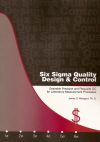Advanced Quality Management / Six Sigma
Translating Method Validation Data into Sigma Metrics
Six Sigma is a useful tool, but how do we convert our measurements and and compare our processes to the Six Sigma scale. This lesson explains how to use method validation data to convert measurements typically made by the laboratory into Sigma-metrics. Using Sigma-metrics, you can make a definitive decision on the suitability of a method for your applications. (Preview)
- What is Six Sigma?
- What do you need to go from Method Validation to Six Sigma?
- What do you do with the Method Validation data?
- What's a quality requirement and where do I find it?
- Calculating Six Sigma metrics from Bias, CV, and Quality Requirement
- What does it mean when a test has 2 widely different metrics?
- Conclusion
- Postscript
Note: This essay is a synthesis of ideas and applications of Method Validation, Six Sigma, and QC Design. It assumes you are familiar with many of these concepts, but if you aren’t, there are links to essays and lessons with in-depth coverage. The main goal of this essay is to show how to put Method Validation together with Six Sigma Metrics in order to make a definitive decision on the suitability of a method for your own application.
Recently, we had the opportunity to examine and review a method validation study of a POC chemistry instrument. (This instrument, for reasons that will soon become clear, shall remain nameless.) At first glance, the method validation study indicated that this instrument had methods of excellent quality. However, method validation studies are notoriously hard to interpret. Typically a large amount of data is used, multiple experiments are performed, and dozens of statistics are generated, with numerous graphs, to summarize the findings. At the end of the day, however, there is often no clear conclusion about the acceptability of the new methods. All the data and statistics don’t come together to support a definitive yes or no, good or bad decision. While the authors of this particular study praised the instrument and the manufacturers who had commissioned the study, it was really not clear why they believed the instrument was so great.
In the absence of a clear verdict, many labs latch onto the correlation coefficient as the be-all and end-all of a method validation study. If r is near its ideal value of 1.00 (or above 0.90 or 0.95), conventional lab wisdom has it that the method is good. And in our example study, the authors typically spoke about correlation as if it were the most significant fact in the details of each method. As we shall see, conclusions of this nature may be far from the truth.
The good news is that there are ways to eliminate confusion about a method validation study. One of them is to understand the statistics better. Another is to use a Method Decision Chart. Still another technique is to translate the method validation results into Six Sigma metrics. Once converted into Sigma metrics, the numbers are stark, the conclusions are clear, and your decision is simple.
What is Six Sigma?
A huge volume of work has accumulated about the topic of Six Sigma. There are several detailed articles about it in our public archives. To reduce (and oversimplify) Six Sigma, there now are "Sigma metrics" that provide a universal benchmark for process performance. The performance of all processes can be characterized on the "Sigma scale." Values typically range from 2 to 6, where the goal for "world class quality" is 6. If the Sigma metric is less than 3, you’ve essentially got a process that is so unreliable it shouldn’t be used for routine production. A process with a low sigma metric will cost you a lot of time and effort to maintain. To give you a benchmark for understanding process performance on the sigma scale, airline baggage handling is about a 4 sigma process. We hope that healthcare, including laboratory tests, has a better Sigma than that!
Let’s find out!
 Want to read more of this article?
Want to read more of this article?
We invite you to purchase the Six Sigma QC Design and Control manual, Second Edition, available at our online store. You can also download the Table of Contents and a Sample chapter.
